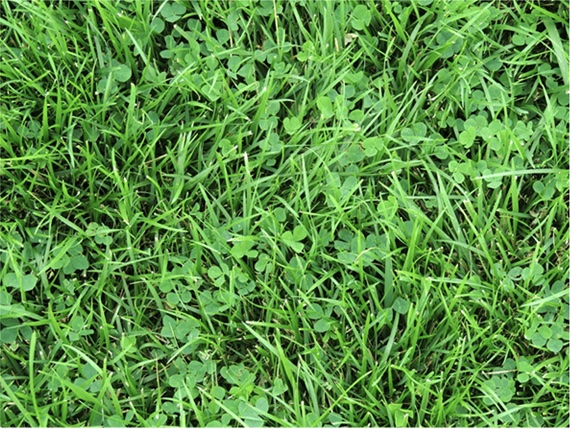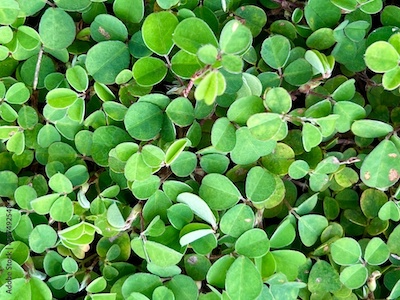The Promise of a Low-Input Tall Fescue/Microclover Lawn
by Brian Lathrop, Fairfax Master Gardener
We Americans are notoriously fond of highly manicured grass lawns, but we also are increasingly sensitive to the ecological hazards created by the synthetic fertilizers that are used for their care. Introducing clover into fescue lawns is an increasingly popular way to maintain an aesthetically pleasing lawn, while reducing the requirement for nitrogen fertilization.
All clovers are legumes. Through a symbiotic relationship with Rhizobium soil bacteria, legumes transform atmospheric nitrogen gas into an organic form of nitrogen that can be used by plants. Prior to the introduction of broadleaf herbicides in the 1950s, clover was a valued component of lawn seed mixtures for its ability to fix nitrogen, enrich the soil and improve turfgrass growth.

Traditional white clover
Traditional white clover has a clump forming habit, which is problematic when trying to use white clover as an alternative to a fescue lawn or even to incorporate it into a fescue lawn. The intense summer weed pressure of the Mid-Atlantic transition zone quickly overwhelms large stands of clover. The primary culprit is ground ivy, Creeping Charlie (Glechoma hederacea), which infiltrates clover stands in the spring, leading to infestation of the stands by all manner of summer weeds, including Japanese stiltgrass (Microstegium vimineum). Worse, herbicides that effectively control these weeds also kill clover.
A solution may be to overseed microclover (e.g., Trifolium repens L. var. Pirouette) into a dense sward of tall fescue (Festuca arundinacea), optionally blended with Kentucky bluegrass (Poa pratensis). When microclover is interspersed into a tall fescue sward in the right amount, the microclover slowly but steadily fertilizes the tall fescue, helping it to compete aggressively with weeds. The mixed sward should work well with the soil food web to create a heat, drought and flood resistant turf. The tradeoff is that microclover produces fewer flowers compared to traditional clovers.

Turf-type tall fescue and microclover mix
Microclover has smaller leaves and a lower growth habit than white clover, enhancing its durability in tall fescue lawns that are mowed to 3.5 inches (9 cm) — the optimal height to compete with weeds. Miniclover® is a type of microclover that grows only about 4 to 6 inches tall (10 – 15 cm). Microclover mixes uniformly into a dense stand of tall fescue, as shown in the photo. This combination of the two plants may be the best solution to withstand heavy weed pressure.
Incorporating microclover could solve the hazards created by nitrogen fertilization. Tall fescue lawns in the Mid-Atlantic region annually need 2 to 3 pounds nitrogen per 1000 square feet to maintain satisfactory tall fescue density to combat weeds. Simple cultural practices, e.g., leaving clippings, can reduce that requirement to 1 to 2 pounds per 1000 square feet.
Incorporating ‘Pirouette’ into the tall fescue stand reduces the annual nitrogen requirement by 1 to 2 pounds per 1000 square feet. It appears that microclover could significantly reduce — if not eliminate — the nitrogen fertilizer needed to maintain a satisfactory density of tall fescue.

Microclover closeup
Microclover in Lawns
Microclover (like tall fescue) has poor shade tolerance and should not be expected to persist in shady sites. Microclover generally performs well during the summer; however, it can die out under extended periods of heat and drought. Miniclover is advertised as a drought tolerant microclover that does well in partially shaded areas. Persistence is also an issue. Experience suggests a persistence of two to three years.
The homeowner should expect to overseed microclover periodically. Microclover foliage can die back in the winter, as in the winter of 2022 when local soil temperatures dropped to 26 F. The best time to determine whether overseeding will be necessary is in March, when foliage has returned.
Seeding
Most microclover seed formulations are pre-inoculated with Rhizobium leguminosarum biovar Trifolii. The tradeoff is a six-month expiration date. The optimal soil temperature for Rhizobium growth is 77 to 88 degrees (25 – 31° C), and nitrogen fixation falls off at a soil temperature of 95 (29° C), so expect a mixed clover/fescue lawn to go dormant in the hottest months of summer (like an all-fescue lawn). Rhizobium-legume symbiosis is optimal at a soil pH of 6.0 to 7.0.
White clover germinates at a soil temperature between 41 to 83 (5 – 23° C) with an optimum at 52 to 63 (11 – 17° C). The optimal germination temperature of microclover is presumably similar. Seed germinates in several days at optimal temperatures (5 to 7 days if using Miniclover).
Keeping seed moist, but not excessively wet, is essential during germination. If seeding a grass-free area (e.g., after turf is disrupted), use a leaf rake to bury the broadcasted seed into a 1/4-inch layer (6 mm) of compost (e.g., certified leaf mulch). Mulch may not be necessary when overseeding a dense tall fescue stand; however, mulch will help tall fescue/microclover mixtures establish faster and more uniformly.
The delicate new grass and clover root systems cannot withstand heavy traffic or severe moisture stress for four to eight weeks following establishment. The soil should be moist but not excessively wet during this time. Use light, frequent irrigation, except during rainy periods or cool, overcast conditions. Otherwise follow usual cultural practices when watering fescue lawns.
Adding the right amount of microclover seed is important. The recommended rate for overseeding a turf-type tall fescue lawn is 3 to 4 pounds of grass seed per 1000 square feet. Overseed with 3 to 5 percent by weight (0.12 to 0.2 pounds; 2 to 3 ounces) of ‘Pirouette’ over the same area. If ‘Pirouette’ is seeded at over 10 percent by weight, it may dominate the stand. The makers of Miniclover recommend overseeding the same area of lawn with at least 8 ounces of seed. (Perhaps Miniclover is less aggressive than ‘Pirouette.’) When applying seed to a grass-free area, double the amount while keeping the same weight ratio between microclover and fescue seed.
Conclusion
Many fescue lawns in this area (including mine) are characterized by high phosphorus and potassium levels, thick thatch, low fescue density and heavy weed infestation. Establishing a mixed microclover/fescue sward from such a starting point may not be possible without the heavy use of herbicides and fertilizers — the very treatments that got us into this state. Nevertheless, the possibility of success is well worth the effort.
Resources
Tall Fescue Lawns in the Mid-Atlantic, Thomas Turner and Mark Carroll, University of Maryland Department of Plant Science and Landscape Architecture for Maryland Turf Council
Lawns and Microclover, Christa Carignan, University of Maryland Extension, Home & Garden Information Center
Fertilizing the Home Lawn, Joseph Heckman and James Murphy, Rutgers Cooperative Research & Extension, Fact Sheet FS633